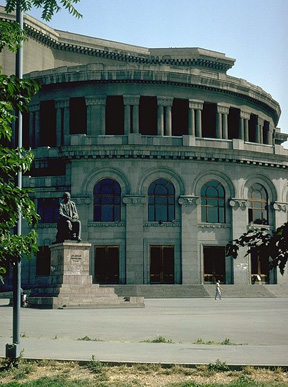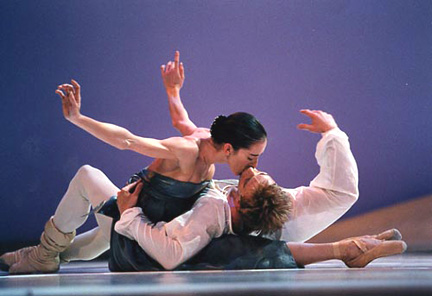Yerevan and Vienna: Viewings
“Don Quixote” by the Armenian Ballet Theater
Yerevan, Armenia
“Walking Oscar” by ZOO
“Romeo und Julia” by Les Ballets de Monte Carlo
Vienna, Austria
March 2007
copyright ©2007, George Jackson
 Yerevan, Armenia’s capital, is no exception: there as elsewhere the Soviets saw to it that their cities had subway trains and a theater for opera and ballet. Fortress-like, the “Operahouse” is one of Yerevan’s dominant structures. Built in 1935, its central oblong rises above the surrounding trees of a park and boulevard setting. On both long sides are galleried semicircular projections. The one facing north is the entrance, lobby hall and auditorium of the Aram Khachaturian Concert Hall. The one facing south, towards the city’s center, is similarly part of the lyric theater — the Alexander Spendiarian National Academic Theater of Opera and Ballet. There’s also in this massive building a nightclub tucked into the eastern shortside of the central oblong which houses, back-to-back, the stages, behind-stage areas and offices belonging to the two big auditoria. Outside, the Operahouse is of a solid gray stone, unlike much of the rest of Yerevan which prefers to build in a red, porous volcanic rock that is deployed rough, matt cut or cut-and-polished to a marble sheen.
Yerevan, Armenia’s capital, is no exception: there as elsewhere the Soviets saw to it that their cities had subway trains and a theater for opera and ballet. Fortress-like, the “Operahouse” is one of Yerevan’s dominant structures. Built in 1935, its central oblong rises above the surrounding trees of a park and boulevard setting. On both long sides are galleried semicircular projections. The one facing north is the entrance, lobby hall and auditorium of the Aram Khachaturian Concert Hall. The one facing south, towards the city’s center, is similarly part of the lyric theater — the Alexander Spendiarian National Academic Theater of Opera and Ballet. There’s also in this massive building a nightclub tucked into the eastern shortside of the central oblong which houses, back-to-back, the stages, behind-stage areas and offices belonging to the two big auditoria. Outside, the Operahouse is of a solid gray stone, unlike much of the rest of Yerevan which prefers to build in a red, porous volcanic rock that is deployed rough, matt cut or cut-and-polished to a marble sheen.
Unusual within the lyric theater (with its 1060 maroon seats, maroon curtains, pink walls, beige ceiling plus white and gold trim) is the stage set-up. The audience faces not one but three proscenia. It is like viewing a triptych, the large proscenium being straight ahead with the somewhat smaller ones angled forward on the sides. Three crystal chandeliers are suspended from the ceiling, one for each of the proscenia. At most performances, only the central stage is used and the side ones remain curtained. So it was on March 10, 2007.
What a delight to find a ballet company of good caliber “off” the beaten path! Armenia has cherished at least this heirloom from Soviet times. The production was a three-act “Don Quixote”, the “after Petipa” ballet to Minkus music, staged by Vilen Galstian. His version wouldn’t disappoint anyone used to “Don Quixote” by the Bolshoi or Kirov. It is somewhat reduced in length — there is no gypsy camp scene (although a gypsy dance is incorporated into the inn scene) and there is no ducal entourage (at whose palace the Act 3 festivities take place is unspecified). I particularly liked Galstian’s handling of the Gamache character as nouveau riche rather than just a dandy. Kitri rebuffs Gamache’s courtship for that reason, whereas she recognizes nobility in the behavior of the old, impoverished Don. Also well and meaningfully constructed in Galstian’s production is a courtly pas de six for the Don, the plot’s principal lovers (Kitri and Basil), Gamache and Kitri’s two Flower Girl friends. The style of the scenery is semi-modern.
Youth dominated this cast. 18-year old Mary Hovannisian, the evening’s Kitri (one of four dancers currently in the role according to the printed program), is petite yet strong. She’s fast, one or the other of her pointes often reaches an ear, and long balances are no problem. Like the Bolshoi’s Natalia Osipova, though, Hovannisian is at times a touch hard. As the Basil, Ruben Muradian (one of three men currently in the role) has not only technique but elegance. He’s tall and when he lifted Hovanissian, her vigorous jumping became effortless gliding. At age 17, Muradian is still growing. Kitri’s two Flower Girl friends (Ana Gostanian and Lilit Asdvadatrian) seemed junior versions of Hovannisian, as did some of the female corps. More senior and quite chic was Maria Divanian as the Street Dancer, Mercedes. Espada, her Toreador, was short wiry A. Gevorkian who looked past his peak. The dancing of the tall Dryad Queen, Sona Arustanian, had downiness and the pert Cupid was J. Sarkoshian. The mimes (Hracht Hovannisian as the Don, Razmig Gostanian as Sancho Panza, Garoush Khunoyan as Gamache, et al.) were respectable. The company numbers about 60 dancers. Directed by former singer Kamo Hovhannisyan, the Armenian Opera and Ballet Theater schedules opera more often than ballet.
During a stopover in Vienna, I saw no Viennese or even Austrian dance but two imports. At the Tanzquartier’s Hall G on March 16 was a dancicle, “Walking Oscar”, by Thomas Hauert, a Swiss resident of Belgium. To me, pop songs usually sound like noise and so did the whiney ones of this production by Hauert’s troupe ZOO. The texts were by the Netherlands author, Oscar van den Boogaard. I preferred Alejandro Petrasso’s piano-only music to his tunes for the songs. As for movement, this dancicle had a few intriguing moments of off-beat balancing but that was it.
 Les Ballets de Monte Carlo’s “Romeo und Julia” gave the impression that Jean-Christophe Maillot, the company’s director and the work’s choreographer, is fighting to find a distinctive language of motion. He has based it on ballet but almost every move is forced. The dancers’ joints don’t articulate; rather, they snap open angrily. Stances are provocatively belligerent. It seems what Maillot has achieved is a jargon, a rather militant one. True languages are richer. As a dramaturg, Maillot’s ideas were good and bad. His best divergence from the traditional scenario for Prokofiev’s music was in Act 2, replacing the street divertissements with a puppet play that foretells the fates of Romeo and Juliet. Maillot’s worst alteration was omitting Lord Capulet from the roster of characters. Without this fearsome father figure our picture of a powerful Renaissance family is incomplete. Juliet, as Bernice Coppieters presented her, was aggressive, gleefully inquisitive and mature — in other words the antithesis of the girlish Juliet, but for no apparent reason other than to be different. I’d like to see the dramatic Coppieters in a suitable role. Francesco Nappa, a brave last-minute substitute for the Romeo of injured Chris Roelandt, would likely have made an imposing Tybalt, the part in which he was originally cast. Samantha Allen was a young yet appropriate Nurse. Without question, the cast worked hard but Maillot’s stilted choreography didn’t give the dancers scope to show their broader potentials.
Les Ballets de Monte Carlo’s “Romeo und Julia” gave the impression that Jean-Christophe Maillot, the company’s director and the work’s choreographer, is fighting to find a distinctive language of motion. He has based it on ballet but almost every move is forced. The dancers’ joints don’t articulate; rather, they snap open angrily. Stances are provocatively belligerent. It seems what Maillot has achieved is a jargon, a rather militant one. True languages are richer. As a dramaturg, Maillot’s ideas were good and bad. His best divergence from the traditional scenario for Prokofiev’s music was in Act 2, replacing the street divertissements with a puppet play that foretells the fates of Romeo and Juliet. Maillot’s worst alteration was omitting Lord Capulet from the roster of characters. Without this fearsome father figure our picture of a powerful Renaissance family is incomplete. Juliet, as Bernice Coppieters presented her, was aggressive, gleefully inquisitive and mature — in other words the antithesis of the girlish Juliet, but for no apparent reason other than to be different. I’d like to see the dramatic Coppieters in a suitable role. Francesco Nappa, a brave last-minute substitute for the Romeo of injured Chris Roelandt, would likely have made an imposing Tybalt, the part in which he was originally cast. Samantha Allen was a young yet appropriate Nurse. Without question, the cast worked hard but Maillot’s stilted choreography didn’t give the dancers scope to show their broader potentials.
This performance on March 17 was at the glassy Festspielhaus of St. Poelten, about an hour’s drive from Vienna. Now in its 10th season, and part of the Kulturbezirk St. Poelten (the “cultural district” also includes a museum, archive, library, studios, a tone tower, an academy etc.), the Festival Playhouse has become an active presenter of dance. It has or had its own dance troupe, the ABCDancecompany, but that now seems to be based in Switzerland. Busses for St. Poelten events depart Vienna (from behind the Staatsoper) a couple of hours prior to starting time and there also are busses from Krems.
Photos:
Top, the opera house in Yerevan.
Bottom, Bernice Coppieters and Chris Roelanndt in "Romeo and Juliet." Photo: Hans Gerritsen.
Volume 5, No. 13
April 2, 2007
copyright ©2007 by George Jackson
www.danceviewtimes.com